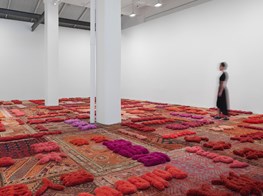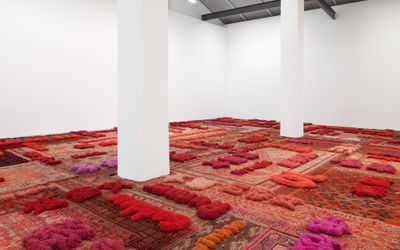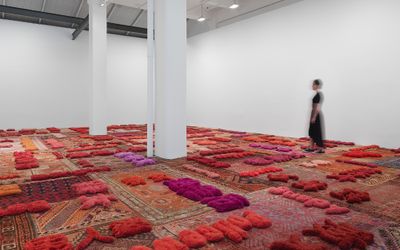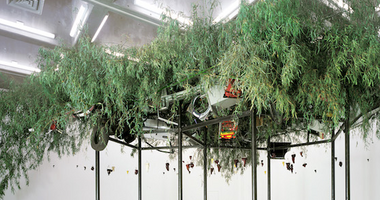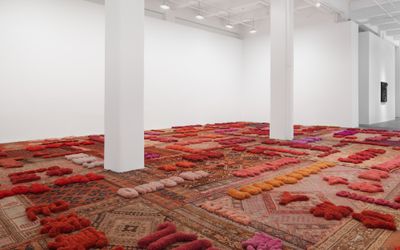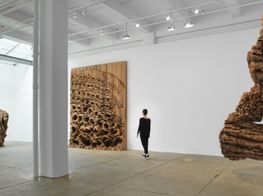Artist Insight: Lin Tianmiao
Although she has not had a major solo show here since the extraordinary Bound Unbound closed at Asia Society in 2013, Lin Tianmiao is currently receiving a good deal of attention in New York City.
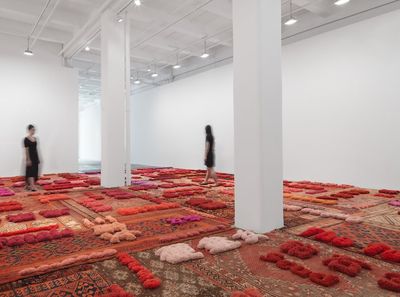
Installation view: Lin Tianmiao, Protruding Patterns, Galerie Lelong & Co., New York (7 September–21 October 2017). © Lin Tianmiao. Courtesy Galerie Lelong & Co.
Her solo exhibition Protruding Patterns (featuring the remarkable large-scale 2014 work of the same title) was at Galerie Lelong & Co., New York, throughout September and October, and her sculpture with video Sewing (1997) is a key work in the recently opened Art and China after 1989: Theater of the World at the Solomon R. Guggenheim Museum.
Tianmiao researched and made Protruding Patterns between 2008 and 2014, during which time she collected something like 2000 words and expressions that are used to describe women in English, French and Chinese. She then selected dozens of these—everything from 'Soccer Mom' to 'Femme Fatale' to 'Cunt'—to weave with wool dyed in bright colours (which she compares to the colours of lipsticks) into dozens of antique Chinese carpets. These were then laid out over the entire floor of the gallery, and visitors were invited to walk on them. As she discusses in the following interview, Tianmiao provided gallery visitors with information sheets on the making and meanings of Protruding Patterns and a lexicon of the terms woven into the carpets.
This interview took place at Galerie Lelong during the run of Protruding Patterns.
Seeing the work in this show it intrigues me that you are reluctant to be thought of as a feminist. Why is that?
Because the term 'feminism' is borrowed from the West. In China it wasn't a grassroots movement among individuals like it was here. It was imported and adopted, so it has an entirely different meaning.
When I first started making art I didn't even really know about feminism as a movement or about its history. I just made the work, without knowing what feminist art was supposed to be or what kind of things it was supposed to embody.
So would it be fair to say that you are concerned with the issues that are central to feminism in the West, but that you've come to those issues without thinking of them as feminist?
Yes. I feel that if I called myself a 'feminist artist', it would be very confining; my freedom as an artist to comment on a wide range of things would be restricted. In fact I consider this body of work as belonging to my past now; using a woman's perspective is something I've worked through now.
It's as though these words are slowly being filtered out of our language and out of recorded history. So it's even more important that I preserve their meanings.
I was struck by the fact that for Protruding Patterns you provided gallery visitors with background notes on how the piece was made, and also a lexicon of the words that it features with many of their meanings. That's rather unusual in my experience. Many artists prefer their work to be more opaque, and they'll say something like, 'I don't need to explain it. I want it to stand for itself.' Why did you think that it was important to provide this background information?
In my earlier work I liked to keep the meanings opaque like you said, or even hidden. But nowadays I feel we're part of societies where we need to understand one another, so the words are very important to the work.
Works like Protruding Patterns can be very popular but people don't necessarily think that they're important. That's partly why I spent years working on it: to show people that it is very important.
Many of the words that I use in the piece—especially the Chinese terms—aren't actually available in dictionaries. When I began the project back in 2008 I started on the internet. But some of these words you can't even find on the internet, and now there are more and more of them you can't find. It's as though these words are slowly being filtered out of our language and out of recorded history. So it's even more important that I preserve their meanings. That's why I did so much research.
Is there a particular sort of word that's disappearing?
Basically they're all being lost. Time plays a natural role, gradually eroding the meaning of words.
I wanted to ask you about the meanings of those words. In your introductory notes you suggest there's a balance between positive words and negative words. My sense though is that they seem to be preponderantly negative and derogatory.
Yes, I recognise that they're mostly derogatory towards women. What I was trying to point out was how these words have evolved over time. In ancient times, for example, women liked to boast about their good points, like how beautiful they were or whatever. But right now in contemporary times women tend to be self-deprecating or to make fun of themselves. I think that's very important.
Do you think that Protruding Patterns actually means something different in New York to what it meant when you first exhibited it in China?
It's important that I used antique Chinese carpets because that gave it a level of cultural familiarity for Chinese audiences. It felt as though it was something from within the country itself, and so people reacted very differently. They were invited to touch it, they were invited to feel its softness and they found it playful or inviting. On the other hand, some people were actually hostile to its explicit feminist ideals. They asked a lot of questions or became angry.
I couldn't predict what the reaction would be in America, but I get the feeling that everyone likes to play on it.
Of course the world was a very different place when you researched and made Protruding Patterns. The United States is now saddled with a president who not only has a very peculiar relationship with women, but a bizarre relationship with China as well.
My work doesn't come from a political perspective, or one that is strictly against one government or one president. It comes from my innermost thoughts as an individual person.
Let's talk a little bit about the Guggenheim show, Art and China after 1989: Theater of the World. It's a hugely ambitious show, but do you think it gives an accurate sense of what has happened in Chinese art between 1989 and 2008?
Overall my opinion is positive. I recognise that it's impossible to be completely accurate; no matter how well it's curated, any exhibition will leave something out. Chinese contemporary art is obviously vast right now so it's impossible to encompass it even in a large survey. In particular, there are many talented young emerging artists whose art is not included in the show.
But having seen this sort of survey show over the past 10 years, they have tended to champion a certain sort of narrative that emphasises Tiananmen Square or Mao Zedong, and those are the themes that are present in the artists' work shown. By contrast, in the Guggenheim show, it's not so much of a presence in the work. I think that's huge progress in terms of how Chinese artists are being considered.
The most important thing that this exhibition establishes is that within the context of global art history China definitely cannot be left out. It makes contemporary Chinese art absolutely unmissable. That is the message of this exhibition: this is a show you cannot afford to miss.
Is there anything about the show you weren't expecting?
I've attended a number of the events that surround the show, and they're mostly sponsored by Chinese businesses. I'm very surprised to see how many businesses are now interested in controlling the production of art. If you compare this with 20 years ago, commercialisation didn't have so much of a powerful impact on art. This is what has surprised me most.
You see commercial sponsorship as an attempt to shape how art evolves?
Basically I am shocked at the emergence of private museums in China. I wouldn't specifically say that this is about controlling the art, but it is a simple observation that 20 years ago in China there were only one to two private museums. Change is coming very fast and I could not have predicted that there would be so many at this point. (In fact my son has researched this and has written a book about it.1)
These corporations and private museums popping up are a cultural phenomenon and you can't control it. Whether you're a Westerner or an Easterner you have no power over it as an individual. These things are just happening beyond your control. But I think that artists are recognising this and adjusting themselves towards it. They're aware these things are happening and they're trying to work within the system, not necessarily against it, if you know what I mean.
Do you think that's a good thing?
It's a system that will cause many people to quit. I think that healthier systems might emerge eventually but it will definitely test every artist's integrity. —[O]
1 Shaun Wang, Snapshot: Independent, Investigative Interviews on Chinese Contemporary "Private Museums", [self published] Beijing, 2017.


